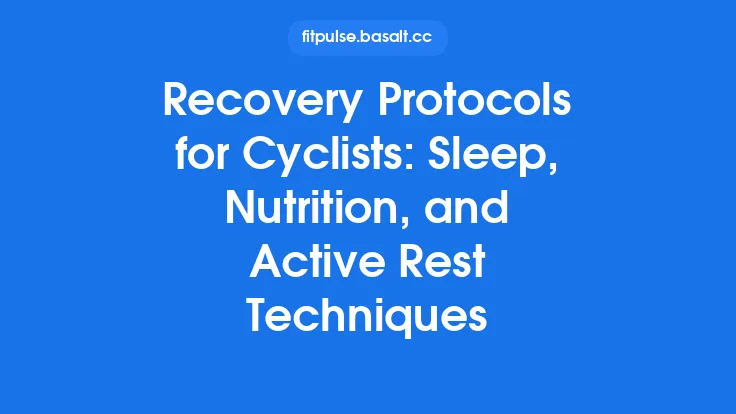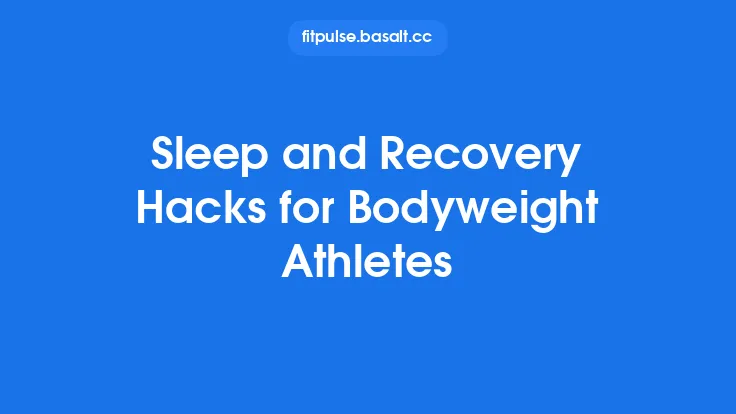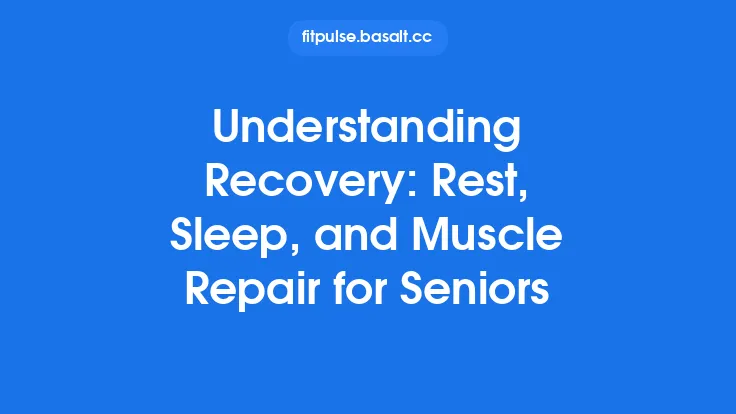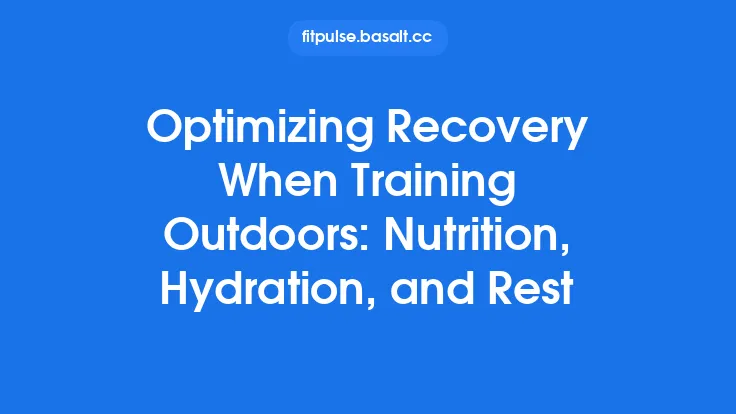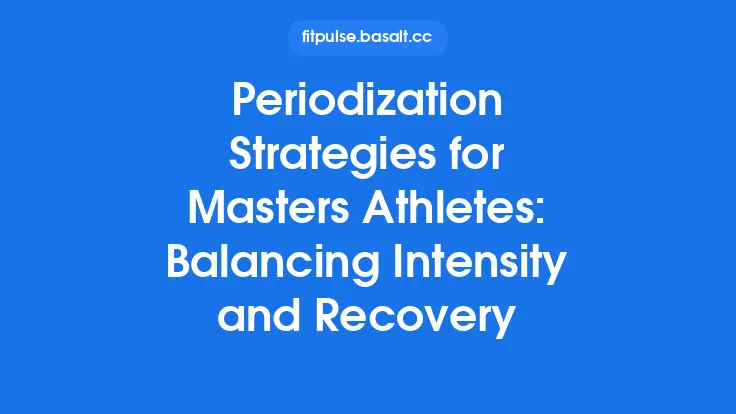Recovery is the cornerstone of sustainable performance for senior and masters athletes. While training plans, nutrition, and skill work often dominate the conversation, the quality of recovery determines whether those efforts translate into long‑term gains or chronic fatigue. For athletes over 50, the physiological changes that accompany aging—such as reduced melatonin production, altered fluid balance, and slower muscle repair—make intentional recovery strategies even more critical. This article delves into three pillars of recovery that are universally applicable: sleep, hydration, and active rest. By understanding the science behind each pillar and implementing practical, evidence‑based protocols, older athletes can preserve health, enhance training adaptations, and extend their competitive lifespan.
The Science of Sleep for the Aging Athlete
1. Why Sleep Matters More With Age
Sleep is the primary window for hormonal regulation, cellular repair, and neural consolidation. In older adults, the proportion of deep (slow‑wave) sleep declines, and sleep fragmentation increases. This shift reduces the secretion of growth hormone and testosterone—both essential for muscle protein synthesis—and impairs the clearance of metabolic waste from the brain. Consequently, inadequate or poor‑quality sleep can blunt training adaptations, increase perceived exertion, and elevate injury risk.
2. Quantifying Sleep Needs
Research suggests that adults over 50 still require 7–9 hours of sleep per night, but the distribution of sleep stages changes. A practical approach is to aim for a minimum of 7 hours of consolidated sleep, with an emphasis on achieving at least 20 % of total sleep time in slow‑wave sleep. Tools such as home polysomnography or validated sleep‑tracking devices can help athletes monitor these metrics, but simple sleep diaries are often sufficient for most.
3. Optimizing Sleep Architecture
| Strategy | Mechanism | Practical Tips |
|---|---|---|
| Consistent Sleep‑Wake Schedule | Reinforces circadian rhythm, stabilizes melatonin release | Go to bed and rise within 30 minutes of the same time daily, even on rest days |
| Light Exposure Management | Blue light suppresses melatonin; morning light advances circadian phase | Get 15–30 minutes of natural sunlight within 1 hour of waking; use amber glasses after sunset |
| Pre‑Sleep Routine | Reduces sympathetic nervous system activity | Engage in 20–30 minutes of low‑intensity stretching, reading, or meditation; avoid screens |
| Temperature Regulation | Core body temperature drop facilitates sleep onset | Keep bedroom at 18–20 °C (64–68 °F); consider a cooling pillow or breathable bedding |
| Nutrient Timing | Certain nutrients support sleep hormones | A small snack containing tryptophan (e.g., Greek yogurt) 30 minutes before bed can aid melatonin synthesis |
4. Addressing Common Sleep Disruptors
- Nocturia: Limit fluid intake 2 hours before bedtime; schedule bathroom trips earlier in the evening.
- Joint Pain: Use a supportive mattress and consider a pillow between the knees for side sleepers.
- Medication Interference: Review any prescription or over‑the‑counter drugs with a healthcare provider; some diuretics or stimulants can impair sleep quality.
Hydration: The Often‑Overlooked Recovery Variable
1. Age‑Related Fluid Shifts
Older athletes experience a blunted thirst response and a reduced ability to concentrate urine, which can lead to chronic low‑grade dehydration. Even a 1–2 % body‑water deficit can impair aerobic performance, cognitive function, and thermoregulation—critical factors for training and competition.
2. Determining Individual Hydration Needs
- Baseline Assessment: Weigh yourself first thing in the morning after voiding. This “dry weight” serves as a reference.
- During Exercise: Weigh before and after a typical training session. A loss of >0.5 % body weight indicates significant fluid depletion.
- Post‑Exercise Rehydration Goal: Replace 150 % of the fluid lost (accounting for ongoing urine output and sweat). For example, a 2 kg loss (≈2 L) requires ~3 L of fluid intake over the next 4–6 hours.
3. Electrolyte Considerations
- Sodium: Essential for maintaining plasma volume. Older athletes with high sweat rates should aim for 300–600 mg of sodium per liter of fluid during prolonged sessions.
- Potassium & Magnesium: Support muscle contraction and nerve function. Include potassium‑rich foods (bananas, sweet potatoes) and magnesium sources (nuts, leafy greens) in post‑exercise meals.
4. Practical Hydration Strategies
| Situation | Fluid Choice | Rationale |
|---|---|---|
| Morning Hydration | 250–500 mL of room‑temperature water with a pinch of sea salt | Replaces overnight losses and jump‑starts cellular hydration |
| During Training (<60 min) | Plain water or a low‑calorie electrolyte drink (≤30 mEq/L sodium) | Prevents over‑consumption of sugars while maintaining electrolyte balance |
| During Training (>60 min, hot conditions) | 6–8 % carbohydrate‑electrolyte solution | Supplies glucose for glycogen sparing and sodium for fluid retention |
| Post‑Exercise | 500 mL of water + 250 mL of a 1:1 carbohydrate‑protein shake (≈20 g carbs, 10 g protein) | Facilitates glycogen restoration and muscle repair while rehydrating |
5. Monitoring Hydration Status
- Urine Color Chart: Aim for a pale straw color (U‑shaped 2–3 on a 1–8 scale).
- Body Mass Fluctuations: Track daily weight; a sudden increase may signal fluid overload, while a consistent decline could indicate chronic dehydration.
- Bioelectrical Impedance Analysis (BIA): Periodic BIA can provide insight into total body water compartments, though consistency in measurement conditions is essential.
Active Rest: Structured Low‑Intensity Work for Recovery Enhancement
1. Defining Active Rest
Active rest (or “active recovery”) involves low‑intensity activities performed on days following high‑load sessions. The goal is to promote blood flow, facilitate metabolic waste clearance, and maintain neuromuscular readiness without adding significant fatigue.
2. Physiological Benefits
- Enhanced Venous Return: Light movement accelerates the removal of lactate and inflammatory metabolites via the venous pump.
- Mitochondrial Biogenesis Stimulation: Sub‑threshold aerobic work can up‑regulate PGC‑1α, supporting mitochondrial health—a key factor in age‑related endurance decline.
- Neural Reset: Gentle proprioceptive drills help preserve motor patterns while allowing central nervous system (CNS) recovery.
3. Designing an Active Rest Session
| Component | Example | Intensity (HRmax %) | Duration |
|---|---|---|---|
| Aerobic Warm‑up | Easy cycling or brisk walking | 45–55 % | 5–10 min |
| Mobility Flow | Dynamic shoulder circles, hip openers | N/A (non‑cardio) | 5 min |
| Low‑Intensity Cardio | Light elliptical, rowing at easy resistance | 55–65 % | 15–20 min |
| Neuromuscular Activation | Single‑leg balance, light band work | N/A | 5 min |
| Cool‑Down Stretch | Static holds for major muscle groups | N/A | 5 min |
Total session time: 30–45 minutes, performed 1–2 times per week, preferably the day after a high‑intensity or high‑volume workout.
4. Modality Options Tailored to the Senior Athlete
- Aquatic Low‑Impact Cardio: Water walking or gentle pool laps reduce joint loading while providing resistance for circulation.
- Recumbent Cycling: Supports the back and hips, allowing a comfortable seated position for longer durations.
- Tai Chi or Qigong: Combines slow, coordinated movements with deep breathing, enhancing parasympathetic tone and balance.
- Foam‑Rolling & Self‑Myofascial Release: Light rolling for 30–60 seconds per major muscle group can improve tissue pliability without excessive strain.
5. Frequency and Periodization of Active Rest
- Micro‑Cycle (Weekly): Incorporate 1–2 active rest days, spaced at least 48 hours after the most demanding session.
- Macro‑Cycle (Seasonal): During competition phases, active rest may be reduced to maintain peak sharpness, but never eliminated; a brief “recovery week” every 4–6 weeks can prevent cumulative fatigue.
6. Monitoring Recovery Response
- Subjective Wellness Scores: Rate sleep quality, muscle soreness, and perceived energy on a 1–10 scale each morning.
- Heart Rate Variability (HRV): While detailed HRV analysis is often covered in other articles, a simple morning pulse‑rate check can indicate autonomic balance—lower resting heart rate generally reflects better recovery.
- Performance Benchmarks: Track a simple sub‑maximal test (e.g., 5‑minute rowing distance) weekly; stable or improving numbers suggest adequate recovery.
Integrating the Three Pillars: A Sample Weekly Recovery Blueprint
| Day | Primary Training | Recovery Focus |
|---|---|---|
| Monday | High‑intensity interval session (running or cycling) | Sleep: Aim for 8 h, incorporate pre‑sleep stretching; Hydration: 500 mL water + 250 mL electrolyte drink post‑session |
| Tuesday | Strength‑focused (moderate load) | Active Rest: 30‑min aquatic walk; Sleep: Consistent bedtime; Hydration: Morning 250 mL water, monitor urine color |
| Wednesday | Moderate endurance (tempo run) | Sleep: Add 15 min of wind‑down meditation; Hydration: 750 mL water during session, replace 150 % fluid loss |
| Thursday | Skill/technique drills (low load) | Active Rest: 20‑min recumbent bike at 55 % HRmax; Sleep: Keep bedroom cool; Hydration: Electrolyte snack post‑practice |
| Friday | Long slow distance (LSD) | Sleep: Prioritize 8–9 h; Hydration: 6–8 % carb‑electrolyte drink; Active Rest: Light foam‑rolling in the evening |
| Saturday | Competition or race simulation | Sleep: Pre‑event nap (20 min) if needed; Hydration: Pre‑race 500 mL water + 250 mL sodium solution; Active Rest: Post‑event gentle walk |
| Sunday | Full rest or optional yoga | Sleep: Allow natural wake‑up; Hydration: Focus on balanced meals with fruits/veg; Active Rest: Optional Tai Chi for 15 min |
Practical Tips for Implementation
- Create a Recovery Log – Record bedtime, wake time, fluid intake, and active rest activities. Patterns emerge that guide adjustments.
- Batch Prepare Hydration Solutions – Mix a low‑sodium electrolyte concentrate in a large jug; portion into reusable bottles for easy access.
- Leverage Technology Wisely – Simple alarms for bedtime, a water‑tracking app, or a timer for active‑rest intervals can reinforce habits without over‑complicating the routine.
- Educate Support Network – Family, coaches, and teammates who understand the importance of recovery are more likely to respect rest days and avoid “push‑through” culture.
- Adjust Seasonally – In hotter months, increase fluid volume and prioritize cooling strategies (e.g., ice‑vests during post‑exercise recovery). In colder months, focus on maintaining bedroom temperature for optimal sleep.
Conclusion
For senior and masters athletes, the margin between progress and plateau often hinges on how effectively they recover. By treating sleep, hydration, and active rest as interdependent pillars rather than optional add‑ons, athletes can mitigate age‑related physiological declines, sustain training quality, and enjoy a longer, healthier competitive career. Implementing the evidence‑based protocols outlined above—tailored to individual preferences and lifestyle constraints—provides a robust, evergreen framework for recovery that stands the test of time.
